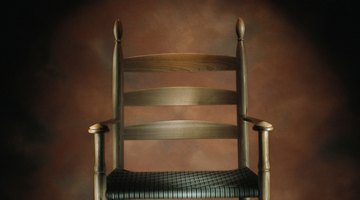How to Identify Shaker Chairs
The Shakers, a religious sect, first came to America in 1774 from England. Shaker communities were largely self-sufficient, which entailed their making practical, handmade furniture pieces for their own use.

Even though some furniture companies today manufacture reproductions of genuine Shaker chairs, you can spot an original by inspecting the item carefully for design clues, such as the type of wood, specialty features, identifying marks and craftsmanship. Locate an expert to confirm a Shaker chair is genuine.
Identifying Marks
A quick indicator that your chair is a reproduction is the absence of any typical age markings -- worn seats, scratched wood and a less-than-perfect finish. Look for special identifiers, such as numbers from the R.M. Wagan Factory, founded in 1872. This company sized their Shaker-made chairs from 0 to 7; look for the stamped number on the back of the front slat of a chair to determine its authenticity. You can also check for a decal on the inside runner of a rocking chair that identifies it as a genuine Shaker chair from the Wagan Factory. Inspect a wood rocking chair for authentic "mushroom caps" on the end of each arm, which are small wood pieces that hold the arm on the front post tenon.
Wood and Colors
Shakers didn't use imported woods, such as rosewood and mahogany, to make their chairs. Examine your chair to see if it is made from pine, maple or cherry, as these American-grown woods were typically used to construct the simple, but well-made seats. Because most chairs made by the Shaker community were covered with a brown-toned stain or a blue, green, red or yellow paint, check your chair for those hues. If your piece is coated with a clear finish or you can visibly see it was repainted, it might still be an original piece, but has undergone some obvious refurbishing.
Embellishments and Construction
If you notice excessive ornamentation on a chair that you are evaluating for authentic Shaker craftsmanship, you can quickly determine it is definitely not genuine. It was the Shaker belief that excessive ornamentation encouraged the sin of pride; thus, this religious sect's chairs feature a minimalist and practical design. Look for simplistic wooden chairs designed with wooden slats or ladder backs and woven rush or cane seats. Some Shaker chairs have a low, single-slat wooden back, which can conveniently slide under a table or hang on a wall when they are not in use. Look for antique specialty wooden chairs with rotating seats, tilting legs or rocking legs that can also indicate an authentic Shaker design.
Expert Advice
When you can't determine whether a chair is genuine or fake, find a professional furniture appraiser who is familiar with Shaker-style chairs to confirm whether you actually have an authentic piece. A certified appraiser can also provide you with a dollar estimate of your chair's value. Acquire the name of a reputable appraiser from your local bank, an estate attorney or another impartial source. Avoid resources that may have a motivation to acquire the property as inexpensively as possible, such as auction companies and second-hand furniture dealers.
References
Writer Bio
Mary Cockrill's education and certifications in interior design and home staging have allowed her to author numerous home-related articles. Cockrill has been a top design consultant for a renowned home store and is the owner of Starwood Home & Gifts, LLC, an interior design, decorating and home staging business. She holds a Bachelor of Science in secondary education with a comprehensive major in office administration.
Photo Credits
- Hemera Technologies/Photos.com/Getty Images
- Hemera Technologies/Photos.com/Getty Images
More Articles



